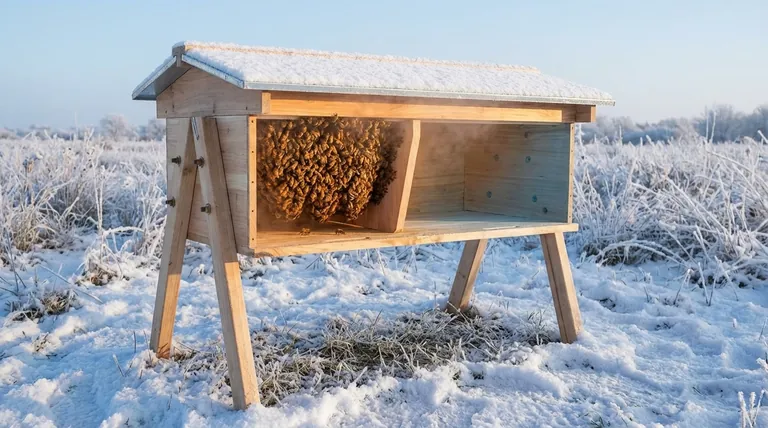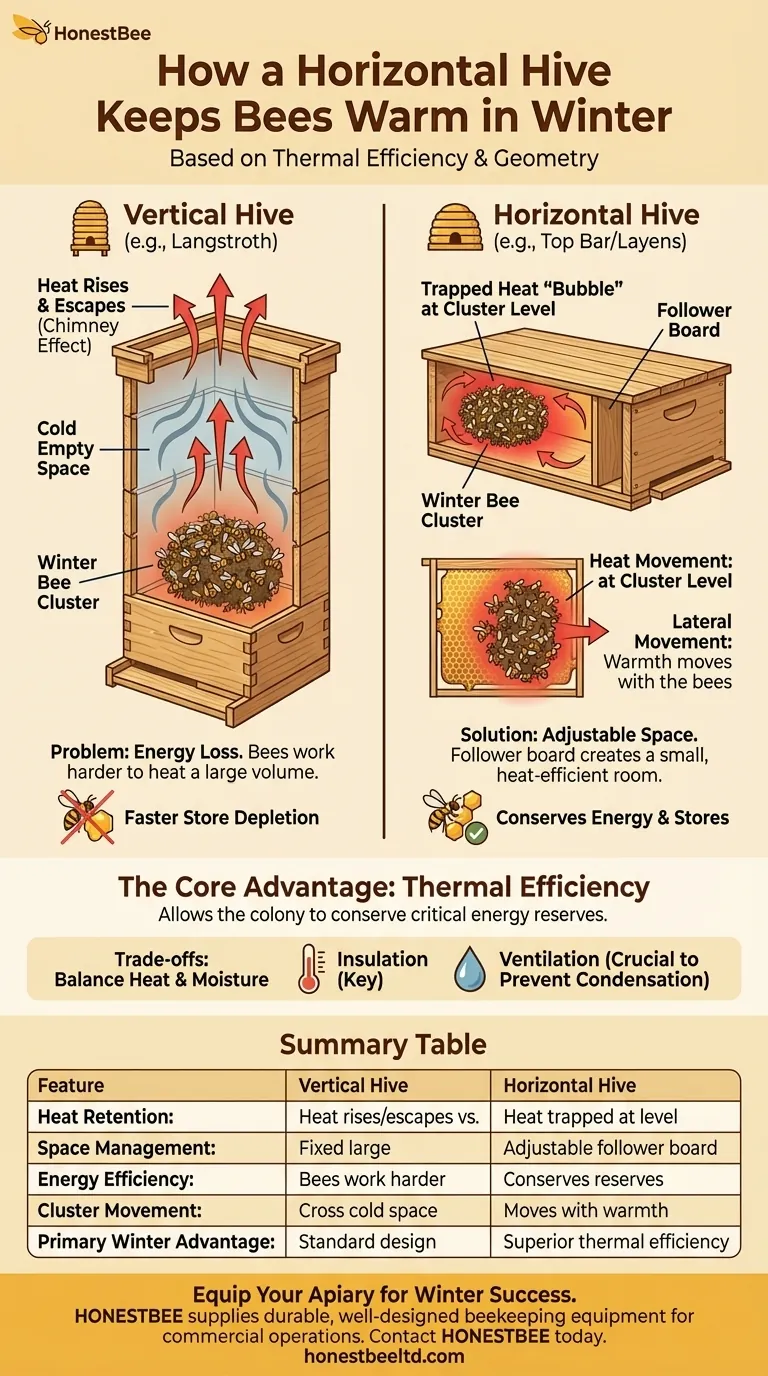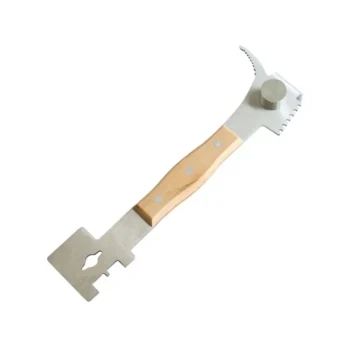At its core, a horizontal hive helps bees stay warm by fundamentally changing the geometry of their living space. Unlike a tall, vertical hive where heat naturally rises and escapes, a horizontal design allows the colony to maintain a compact, energy-efficient heat bubble that moves with them laterally as they consume their winter stores.
The key advantage is not just insulation, but thermal efficiency. A horizontal hive lets bees heat a smaller, more manageable space and prevents the chimney-like heat loss common in vertical hives, allowing the colony to conserve critical energy reserves.

The Physics of a Winter Hive
To understand the advantage of a horizontal hive, we first need to understand the challenge bees face. Their survival depends on maintaining a core temperature in their "winter cluster."
How Bees Create Heat
Bees do not heat the entire hive; they only heat their cluster. They form a tight ball, with bees on the outside acting as an insulating layer and bees on the inside vibrating their wing muscles to generate heat.
This process consumes enormous amounts of energy, which comes directly from their stored honey. The more energy they spend on heat, the faster they burn through their winter food supply.
The Problem with Vertical Space
In a standard vertical hive, like a Langstroth, heat naturally rises. The warmth generated by the cluster on the lower combs travels upward, dissipating into cold, empty boxes above.
This creates a "chimney effect," constantly pulling precious warmth away from the bees. The colony must work harder and burn more honey just to compensate for this continuous heat loss.
How a Horizontal Hive Optimizes Warmth
A horizontal hive, such as a Top Bar or Layens hive, is designed to work with, not against, these thermal dynamics. It offers two primary mechanisms for superior winter performance.
Controlling Volume with a Follower Board
The most direct benefit is the ability to adjust the hive's interior volume. A solid "follower board" can be inserted to wall off any unused portion of the hive.
This creates a smaller "room" for the bees to occupy. Just as a small room is easier to heat than a large one, a constricted hive cavity allows the colony to maintain its cluster temperature with far less effort.
Keeping Heat at the Cluster Level
The horizontal layout itself is a major advantage. Because the hive is long instead of tall, the heat generated by the cluster remains at the level of the bees. The ceiling is right above them, trapping warmth where it is needed most.
As the colony consumes honey and needs to move, they shift sideways along the combs. Their "bubble" of warmth moves with them, ensuring they are never forced to cross a large, cold, empty space to reach their next meal, a perilous journey in a vertical hive.
Understanding the Trade-offs
While thermally efficient, a horizontal hive is not a magic bullet. Proper management requires understanding the balance between heat retention and moisture control.
The Need for Adequate Insulation
The hive's design helps manage heat, but the material itself provides the insulation. All wooden hives offer some natural insulation, but in very cold climates, additional external insulation may still be necessary to provide a buffer against extreme temperatures.
The Danger of Condensation
A perfectly sealed hive is a death trap. As bees respire, they release warm, moist air. If this air hits a cold inner surface, it will condense into water droplets.
This cold "rain" can drip down onto the cluster, chilling the bees and leading to their death. A small amount of upper ventilation is crucial to allow this moist air to escape, ensuring the bees stay dry. A dry, cold bee can survive far better than a wet, cold bee.
How to Apply This to Your Project
Your goal is to help your bees manage energy and moisture. The hive's design is a tool to achieve that.
- If your primary focus is maximizing winter survival: The horizontal hive's ability to keep heat concentrated at the cluster level is its single greatest advantage over a vertical design.
- If you are managing a new or small colony: Use a follower board to aggressively reduce their space, giving them the best possible chance to conserve energy and build up strength.
- If you are preparing any hive for winter: Prioritize moisture control above all else. A dry and ventilated hive is more critical for survival than a perfectly warm but damp one.
By understanding how a hive's geometry impacts its internal environment, you can better support your bees' natural strategies for surviving the winter.
Summary Table:
| Feature | Vertical Hive (e.g., Langstroth) | Horizontal Hive (e.g., Top Bar/Layens) |
|---|---|---|
| Heat Retention | Heat rises and escapes (chimney effect) | Heat is trapped at the cluster level |
| Space Management | Fixed, large vertical space | Adjustable volume with a follower board |
| Energy Efficiency | Bees work harder to compensate for heat loss | Conserves critical honey reserves |
| Cluster Movement | Must cross cold, empty space to reach food | Warmth 'bubble' moves laterally with the bees |
| Primary Winter Advantage | Standard design | Superior thermal efficiency for survival |
Equip Your Apiary for Winter Success
Understanding hive thermodynamics is key to protecting your colonies. As a commercial beekeeper or distributor, ensuring your bees survive the winter is critical for your operation's productivity and profitability.
HONESTBEE supplies the durable, well-designed beekeeping equipment you need. Our wholesale-focused operations provide commercial apiaries and distributors with reliable horizontal hives and other essential supplies built to enhance bee health and winter survival rates.
Let's discuss how our equipment can support your goals.
Contact HONESTBEE today to learn more about our product range and wholesale options.
Visual Guide

Related Products
- Long Langstroth Style Horizontal Top Bar Hive for Wholesale
- Professional Insulated Winter Hive Wrap for Beekeeping
- Ergonomic Two Person Foldable Hive Lifter
- Multi-Function Hive Tool with Integrated Hammer for Beekeeping
- Wholesales Dadant Size Wooden Bee Hives for Beekeeping
People Also Ask
- What are the most popular types of hives besides the Langstroth? Top Bar & Horizontal Hives Explained
- What are the main differences between Langstroth hives and top bar hives? Choose the Right Hive for Your Beekeeping Goals
- What is a top bar bee hive? A Natural, Low-Stress Beekeeping Solution
- What are the advantages of a top bar hive? Simpler, Bee-Centric Beekeeping for All
- What are the box management requirements for a top bar hive vs. Langstroth? Choose Your Hive Strategy



















